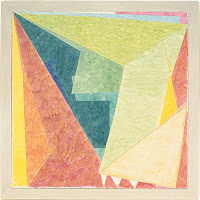Can you briefly describe what you do?
I make oil paintings that begin with color relationships and develop spatial relationships between forms that become proxies that can move in and out of contexts.
What drives you to make work?
I’m driven by the want to see something new come from my hand. Over time I have developed parameters for working that allow me to be intuitive each time I paint. I need my work to surprise me.
Can you tell me something of your day-to-day working practices?
Mixing color is very important. As I lay out the paint on my palette, I begin to formulate the general outline of a painting in my mind. As I put down an under-painting, I decide which color to begin with and what form it will take. Since I work within a set of parameters (scale, form, action and material) I can let each decision lead to the next.
How long have you been working in that way?
I began working this way in grad school in 2004, though the paintings looked quite different. I’ve let my practice change slowly over time, but the basic elements remain.
Which artists have had the greatest affect on your work?
I love painters, of course- I still can’t get over the late Bonnard paintings that were shown at the Met in 2009. Gauguin was one of the first painters whose color really struck me. Paul Klee became a huge influence because of his seeming willingness to let one thing lead to the next. I’m always drawn to medieval paintings with the very shallow space the figures inhabit and the strange forms that you see in the background landscapes. I also like minimalist work from the 60’s and 70’s- Donald Judd and Sol Lewitt. I love the materiality of James Ensor. I like the rhythm of Guston’s marks and how he described objects with paint. Tomma Abts’ paintings really surprised me when I was able to see them in person. She makes clever decisions denying a view of some parts and revealing others.
What, outside visual art, informs your practice?
I appreciate the structure of music and how directly it can affect me. Growing up, there was always music playing on the stereo and I still cannot go long without some kind of background noise. My taste in music is eclectic, but that doesn’t mean it’s not specific. When I’m painting I could be listening to Charles Mingus, Outkast, Terry Riley, Gillian Welch or Jawbreaker, but I take time to choose the right music every day. I also like reading philosophy, but I wouldn’t say it directly relates to my work. I like it because some philosophers create their own logic that can spiral into an abstract series of relationships. Reading it can change the way I organize my thoughts.
How would you like people to engage with your work?
I like to think that paintings can be autonomous for at least that moment when you first view them. I hope people take advantage of their right to judge art. Too often we want to be told how to look at work. When I finish a piece and display it, I want it to exist outside of my intentions. Then we can argue about it!
Have you seen anything recently that has made an impression?
I recently saw the Blinky Palermo retrospective at the Hirshhorn. I appreciate the way he just kept reworking the rectangles and yet each painting holds up as a striking object. Seeing them together also worked well because his attention to scale is so apparent. And the use of color is just so succinct and smart.










